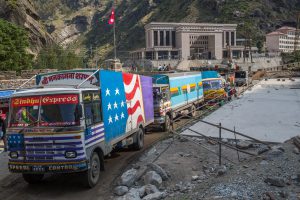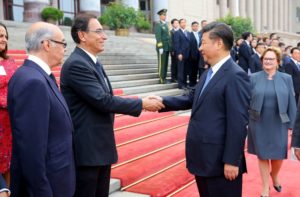India’s Prime Minister, Narendra Modi, has come back to power with a large majority, exceeding that of the one he received in his first term in 2014. At his inauguration he invited the leaders of the Bay of Bengal Initiative for Multi-Sectoral Technical and Economic Cooperation (BIMSTEC) countries, which include (other than India) Bangladesh, Myanmar, Sri Lanka, Thailand, Bhutan and Nepal. This choice, and long-term commitment by India to integrate the regional economy, has focussed attention on the possibility of energy trade as a way of both promoting regional cooperation as well as simultaneously dealing with energy demand and carbon emissions.
Two recent reports have made this the focus of their work. The more detailed report was published a few months before the election, in February 2019, by the Economic Research Institute for ASEAN and East Asia (ERIA) on the request of the Confederation of Indian Industries (CII). One of the authors had focussed on these ideas in a 2016 report for the Observer Research Foundation (ORF), a think tank based in New Delhi.
After the new government’s inauguration ceremony, a report from the media portal CarbonCopy also focussed on this outreach as a possibility of green growth, specifically as an alternative to China’s carbon-heavy development through its Belt and Road Initiative (BRI).
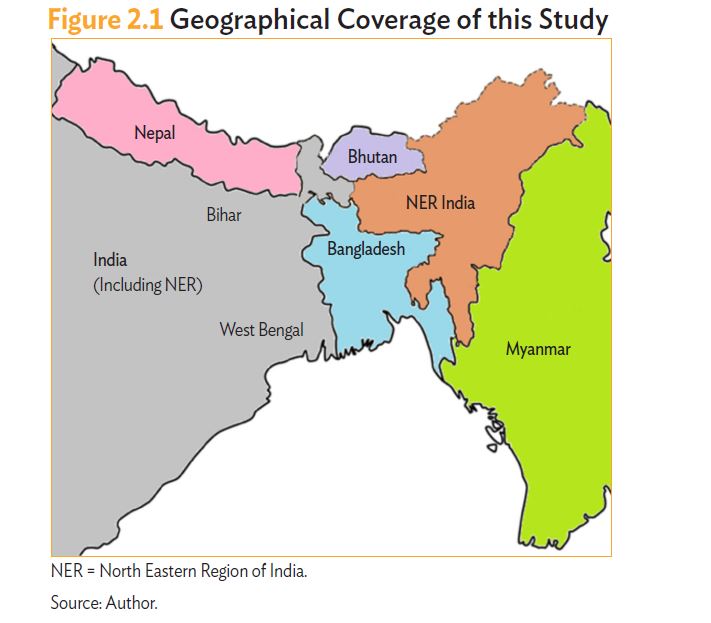
The ERIA report focussed primarily on India’s northeast region, which has – because of a mix of political and infrastructural challenges – been one of India’s least developed regions. In 1991 India instituted a Look East Policy, premised on developing the northeast as a point of connection to its eastern neighbours. As the ORF report notes, “This eastern frontier has over 52% (7,917 km) of the total land borders of 15,106 km of India: 4,096 km with Bangladesh; 633 km with Bhutan; 1,346 km with China; 1,643 km with Myanmar; and 199 km with Nepal.”
Transforming these borders into sites of cooperation and trade rather than conflict has been an important policy objective of the Indian government for the last three decades.
During his first term in office Narendra Modi paid special attention to the region, and renamed the policy from Look East to Act East. He also made a point by choosing Bhutan as the first country to visit. Nevertheless the level of transboundary cooperation has not seen a transformative change. A transboundary motor vehicles agreement between Bhutan, Bangladesh, India and Nepal foundered over environmental and other concerns in Bhutan in 2016, and while an inland waterways cooperation between the four countries is being pursued, it is yet to be operationalised.
An energy transformation
Energy could be the issue that could change all this, according to the ERIA report. There is good reason to think so. The northeastern region of India is both poorer and more energy starved than the rest of India.
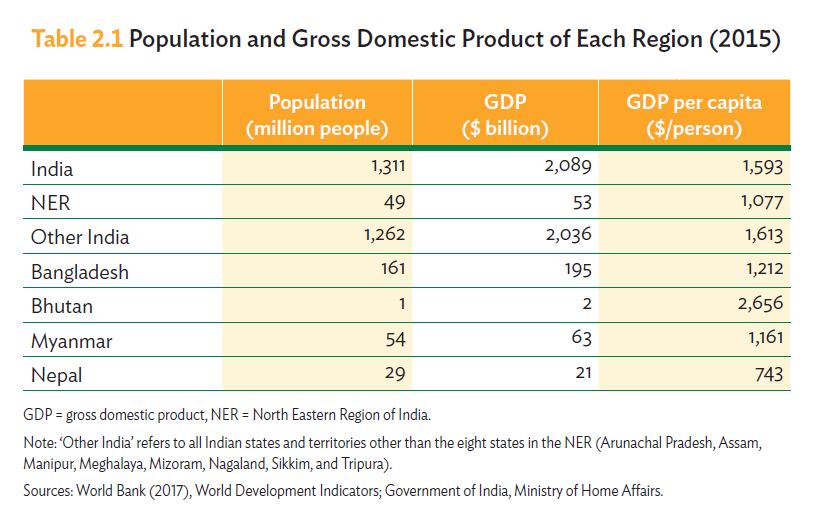
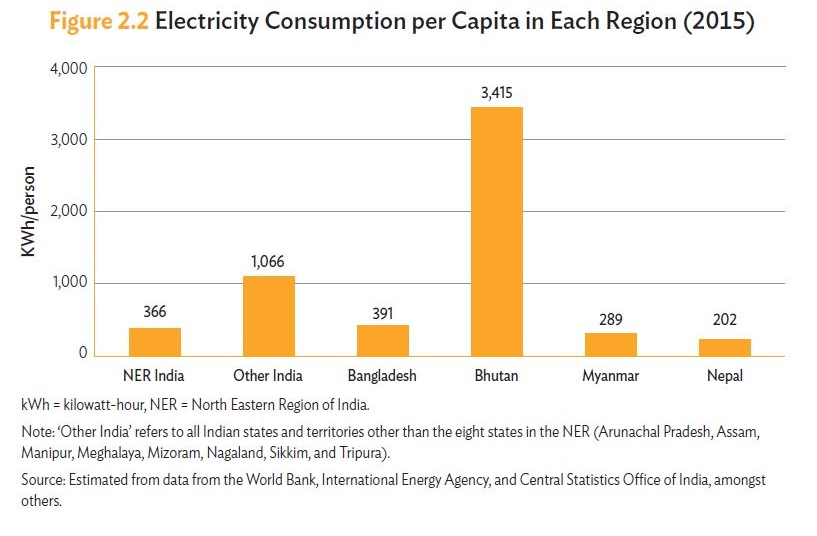
India’s northeastern region sits at a juncture where it could make a large transition. The area’s hydropower potential has been largely unutilised, principally due to poorly-planned projects that have led to protests by residents and environmentalists. Bhutan, which draws its largest revenue from selling its hydropower-produced electricity, is keen to secure more markets. Nepal, which is energy poor, but plans to develop its large hydropower resources, would also like to put these on the market. At the same time Bangladesh has prioritised energy as key to its development policies, and Myanmar remains energy poor.
Cross border energy trade makes eminent sense in such circumstances, especially as India is already exporting power to some of these countries (Bangladesh, plus Nepal and Bhutan during the non-monsoon season when their run-of-the-river hydropower projects do not produce enough electricity) on a bilateral basis.
The CarbonCopy report goes further, arguing that the cross border energy trade could be 100% renewable energy, providing a green alternative to carbon-heavy growth being pursued by countries under the China-led BRI. China has recently outstripped India as the main investor in Bangladesh, but much of this investment is in coal-based power plants in a country that has no coal reserves, and is on the frontlines of sea-level rise and other climate change-induced challenges.
Concerns and challenges
Given these obvious positives, it is likely that India will pursue these opportunities with enthusiasm, but an implementation of a cross border energy trade is not without its hazards. The CarbonCopy report lists a number of cautionary notes, from Nepal’s minister rueing that India’s new energy policy still seems to be focussed on bilateralism rather than multilateralism, to an analyst from Myanmar speaking of “negative experiences” in the past limiting their enthusiasm. The problems of the BBIN motor vehicles agreement, which failed to take into account possible problems in Bhutan, shows that due care needs to be taken in pursuit of such enterprises. Without an established grid and power sales agreement in place, the building up of hydropower resources in Nepal and India’s northeast will be an economic challenge, as investors are unlikely to see the point given the current low demand in these areas. Most of the electricity will have to be for export.
But hydropower in the northeast and Nepal have to be approached cautiously. Hydropower development in the Himalayan region – with the exception of Bhutan – has often been at the cost of local communities rather than to their benefit. In India’s northeast this takes on more urgency as the region is already less developed and less prosperous than the rest of India. Such high investment projects are likely to be led either by the central government, or large outside investors, and voices from the communities most affected need to be factored in. Arunachal Pradesh’s pursuit of hydropower should also act as a lesson, as nearly a dozen years after their inception many projects are either still not built, abandoned, or stuck in bureaucratic process.
The idea of a “green” cross border energy trade, as posited by the CarbonCopy report, may also suffer due to the hydropower conundrum. Neither solar power or wind power are currently developed enough to supply the amount of electricity needed, although solar power installation is growing fast in India. The CarbonCopy report looks at a mix of all renewables as part of this grid, but given the hydropower potential in the northeast, Nepal, and Bhutan, it is likely to dominate for the short-term at least. One of the problems with renewables is that peak electricity demand in the northeast is between 6 pm and 10 pm (and is likely similar in neighbouring countries), when there is no sunlight. In the case of hydropower plants in Sikkim and West Bengal this has led to hydropower dams holding water for 20 hours a day, and releasing them when electricity generation is most profitable. This daily shift ravages the river and all life within it.
The ERIA and CarbonCopy reports both note that – with an enhanced energy grid – carbon emissions can drop by 9%. While this sounds impressive, it neglects the fact that carbon emissions overall are set to rise by a large margin across all these countries. Despite India’s commitment to expand its renewable sector to make up more than 50% of its energy generation, coal based power plants – all of them currently far less efficient in their use of water than in developed countries or China –will remain the single largest energy source. These will also form the backbone of the energy system that will drive India’s energy exports. A 9% drop is, therefore, good overall, but not equivalent to a green transformation.
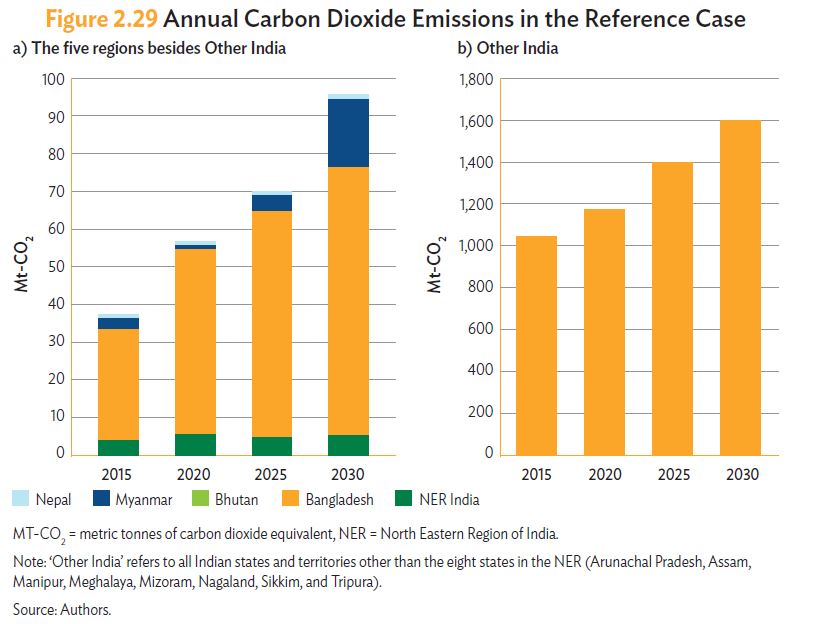
Another thing that all the reports ignore, despite citing the example of the Mekong, is how problematic the export of electricity has been for locals. Protests against large dams, many of which export power to other regions or even other countries, has consistently been a thorny issue. While looking at the energy trade in the Greater Mekong Subregion as an inspiration, the authors gloss over the problems inherent in the way that the trade has been pursued.
Lastly there are still severe political problems in the region. With a million Rohingya refugees from Myanmar in Bangladesh, an agreement involving the two countries will face political difficulties. In India’s northeast, just before the elections closed, a politician and ten others were murdered by a militant organisation.
None of this means that such regional energy cooperation is not desirable. In fact these problems highlight exactly why cooperation is needed. The real question is whether the politicians in the various countries, and their bureaucracies, possess the sensitivity and urgency to pursue such a project in ways that are more fruitful than they have in the past.
![<p>While abundant water is Nepal’s blessing, haphazard hydropower planning is likely its major curse [image by: Asian Development Bank]</p>](https://dialogue.earth/content/uploads/2017/09/Kali-Gandaki-A-ADB.jpg)


